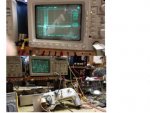190121-1111 EST
tersh:
Since you have now run the experiment where no current flows thru the current transformer this may imply that there is capacitive coupling between the current transformer primary leads and the secondary. If this is what is happening, then it would be because the current transformer lacks an electrostatic shield between primary and secondary.
I could try some experiments on your circuit.
You could when you get them in a week. It's on its way.
Here's a recap how the top works.
The plug metallic terminals were connected to the pcb at the lower left and right side. A green led is connected to them in series with a 200k ohm resistor (in the pcb, the green and red labelling were reversed because the china labeler probably confused what the words mean). Now look at this.
When the contacts were closed, and you put ac supply to input, the load side is energized and the green LED were lit. When the contacts were opened, the top portion and bottom portion is totally disconnected except the switches and red fault led. However, when you put ac supply at load side to test if the sense coil would trip. And the contacts were opened. You would still get a green LED on.
I initially got confused when I first tried this where you asked me to put the ac supply at load. I heard a click and still see the green light. And I continued pressing the motor switch. Later I realized the click was the contacts opening from the trips. And even when the contacts were opened (from the trips). The green led won't turn off because you are applying power to the load side.
Now about the red LED. It's connected as the red LED in the lower part of the circuit shared earlier. In an isolated circuit, the red light stays on. But something is suppressing it so the red led isn't lit in normal operation.
I included the blue and red button for the Test and Reset terminals.
I also included the grounded neutral sense coil and current inbalance sense coil to help determine the composition of the toroids and know if there is electrostatic shielding or not and how it compares to US sense coil toroids and whether this is the sole cause why even when ac supply is supplied to the load side, the gfci trips with same frequency as when it's put in line side. This proved that it was not current inbalance causing the gfci to trip.
Remainder. Do not disconnect pin 1 because it will immediately destroy the SCR and chip. Before they were destroyed. I could see the Red LED turning on or blinking in synchronization to the solenoid clicking so fast and heating up (insulation smoking). It's so mysterious how it could turn on when circuits get damaged.
It seems the chip can self destruct if Rset between 1 and 2 was not put or removed. I thought it was only the SCR destroyed. This was why I cut the SCR in the 4th test circuit. The red light didn't turn on. I resoldered the SCR. Note the SCR was so sensitive. I used used small tweezer to move the SCR of other 1st to 3rd pcbs, and the cover comes up exposing the metal inside the SCR. It may not survive great heat that's why I took effort to reconnect the 3 legs in the 4th working test pcb. The solder may not look nice but there is continuous conduction of the 3 legs to rest of circuit and it's working perfectly.
That's all information I have now. I just don't have access to any oscilloscope for any detailed analysis of both the mysterious red light and exact source of capacitive coupling. And even if I go back to my electronic engineering laboratory, they won't let me touch it because I'm no longer a student, but alumni

And my main interest now is the Higgs field and Large Hadron Collider.
Thank you very much for helping.
About your LED fault circuit. There just has to be some adequate current limiting to the transistor base emitter circuit. If not the transistor would be destroyed.
.
.
















